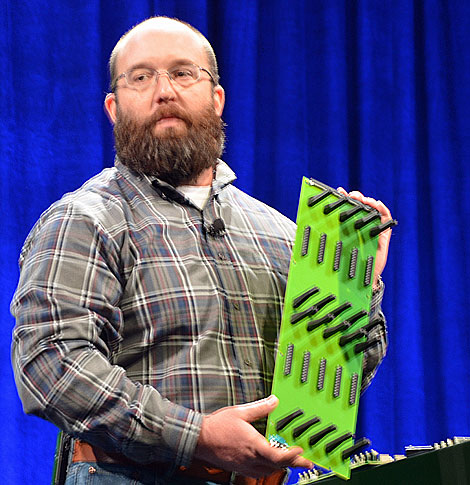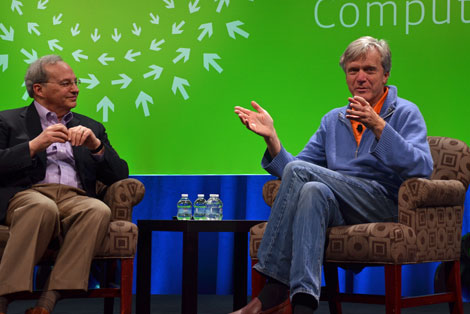
At the Open Compute Summit 2013, Facebook's hardware guru, Frank Frankovsky, displays a board showing common sockets, compliant with the Open Compute Common Slot Specification. It is affectionately known as the "Group Hug" board. Processors from AMD, Applied Micro, Calxeda and Intel can all work with this board. (Photo: Colleen Miller)
SANTA CLARA, Calif. - Perhaps the best sign of the progress made by the Open Compute Project is that companies as diverse as Rackspace Hosting, Fidelity Investments and Goldman Sachs are all running servers based on these "open hardware" designs in their data centers.
In less than two years, the Open Compute Project (OCP) has grown far beyond its origins as a showcase for Facebook's design innovations, evolving into an active community building cutting-edge hardware, disrupting the traditional IT supply chain, and laying the groundwork for future innovation.
More than 1,900 technologists gathered today for the Open Compute Summit at the Santa Clara Convention. That's three times the size of the last summit in May 2012. They packed an expo floor filled with hardware - real, working hardware based on open designs. Meanwhile, the industry's thought leaders took the stage to outline new designs that could accelerate the pace of change in the world's largest data centers.
"The momentum is continuing to build," said Frank Frankovsky, Chairman of the Open Compute Foundation, and VP Hardware Design & Supply Chain at Facebook. "It's really amazing to see the turnout today."
Open Designs, Changing Supply Chain
Hardware and data centers have historically been the stronghold of secrecy and proprietary designs. The formation of Open Compute advanced the promise of open standards for servers, storage, racks and data center design. If it seemed a pipe dream at the time of its launch, the OCP has quickly become real, with some of the U.S. tech industry's largest players - including Intel, AMD and Facebook - rolling out new products.
It has also given a higher profile to a new supply chain featuring original design manufacturers and companies developing low-power processors. A dozen new organizations have joined OCP since the last summit, including storage companies like EMC, Fusion-io, Hitachi, and Sandisk and microprocessor organizations like Applied Micro, ARM, Calxeda, and Tilera.
Several presentations at today's summit focused on new innovations with the potential to change the face of the data center.
"One of the challenges we face as an industry is that much of the hardware we build and consume is highly monolithic — our processors are inextricably linked to our motherboards, which are in turn linked to specific networking technology, and so on," said Frankovsky. " To fix this, we need to break up some of these monolithic designs — to disaggregate some of the components of these technologies frm each other so we can build systems that truly fit the workloads they run and whose components can be replaced or updated independently of each other."
Several OCP initiatives illustrate this opportunity:
- The “Group Hug” Motherboard: Facebook is contributing a new common slot architecture specification for motherboards. This specification, nicknamed “Group Hug,” can create vendor-neutral motherboards with the ability to last through multiple processor generations. The specification uses a PCIe x8 connector to link the SOCs to the board. "Why don't we have a common socket?" Frankovsky asked. "All the surrounding bits are the same."
- Silicon Photonics: Intel is contributing designs for its forthcoming silicon photonics technology, which will enable 100 Gbps interconnects, enough bandwidth to serve multiple processor generations. This technology's ultra low latency could allow components that previously needed to be bound to the same motherboard to be spread them out within a rack. "We'll be able to do things in the data center that we've never been able to do before," said Intel CTO Justin Rattner. "This is really a remarkable breakthrough," added Andy Bechtolsheim, founder and chairman of Arista Networks and a member of the OCP board.
- New Processors and SoCs: AMD, Applied Micro, Calxeda, and Intel have all announced support for the Group Hug board, and Applied Micro and Intel have already built mechanical demos of their new designs.
Frankovsky said the hardware, adoption and innovation on display at the summit demonstrated the power of open collaboration.
"We're building something cool that's unique to the industry," said Frankovsky. "This is a consumer-led organization. I think suppliers are starting to listen more. We're designing and delivering in the open. By doing this in the open, we're creating a virtuous cycle."
That approach got the enthusiastic approval of keynote speaker Tim O'Reilly, a leading light of the open source community, who reviewed the history of how free and open source software had changed the face of computing.
"The important frontier for open source is the cloud," said O'Reilly. "What you guys are engaged in is the invention of the future. I'm so proud that you're taking the future into your own hands."

Intel CTO Justin Rattner,who is an Intel Senior Fellow, Corporate Vice President and director of Intel Labs, and Andy Bechtolsheim, chairman of Arista Networks, discuss the potential of silicon photonics and how they can be used to speed intra-rack communications. (Photo: Colleen Miller)





